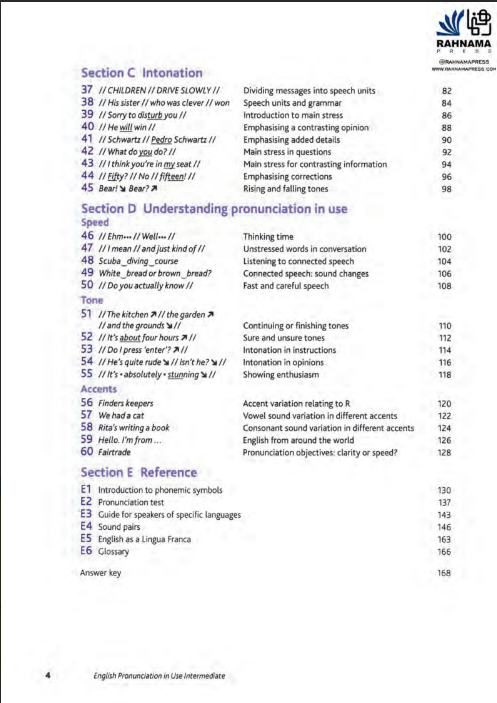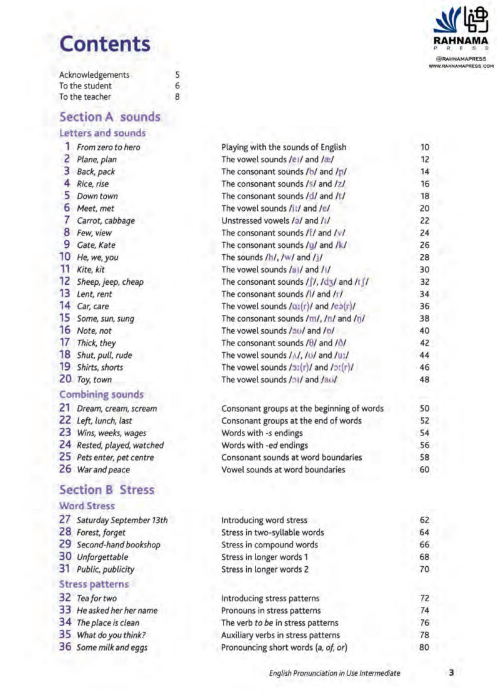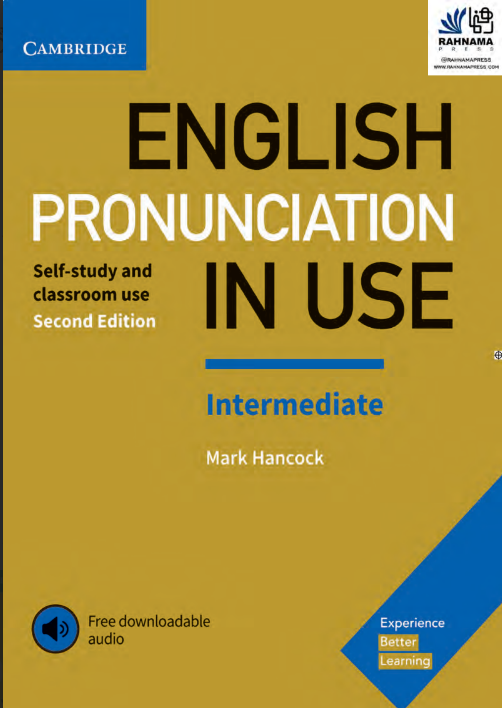


To the student – Introduction to English Pronunciation in Use** **To the student** English Pronunciation in Use is a set of materials to help students of English to work on pronunciation, for both speaking and understanding. It is written mainly for students of intermediate level (B1 and B2). **What will I need?** You will need a phone, tablet or computer to listen to the recorded material that goes with this book. It will be useful if you record your own voice, so that you can hear your own progress. This symbol A1 indicates the track number for recorded material. Also, when you are studying individual sounds, it is sometimes useful if you have a mirror. With this, you can compare the shape of your own mouth to the mouth in diagrams like this one from Unit B. See page 167 for a labelled diagram of the mouth and throat. **How is English Pronunciation in Use organised?** There are 60 units in the book. Each unit looks at a different point of pronunciation. Each unit has two pages. The page on the left has explanations and examples, and the page on the right has exercises. The 60 units are divided into four sections: * **Section A Sounds** (Units 1–26): This section is about how to pronounce and spell the sounds of English, and how to make the differences between the sounds clear. There are also some units about how sounds are joined together. * **Section B Stress** (Units 27–36): This section is about which parts of words and sentences are normally stressed and which parts are normally not stressed. * **Section C Intonation** (Units 37–45): This section is about how speech is divided into speech units and how the position of the main stress can change the meaning of a speech unit. There is also a unit on rising and falling tones. * **Section D Understanding pronunciation in use** (Units 46–60): This section is to help improve your listening skills by pronunciation features in radio interviews and natural conversation. The first group of units deals with the pronunciation features of fast speech. The next group of units helps you to understand features of pronunciation. The last few units deal with aspects of pronunciation which change across different accents of English, both native and non-native. After the 60 units, there is a fifth section, **Section E Reference**, which contains the following: * E1 Introduction to phonemic symbols * E2 Pronunciation test * E3 Guide for speakers of specific languages * E4 Sound pairs * E5 English as a Lingua Franca * E6 Glossary At the end of the book there is an Answer key with answers to all the exercises. **What order shall I do the units in?** You could simply use the units in order, 1–60, but it is probably more useful and interesting to vary the order, e.g. do a unit from Section A, then a unit from Section B, followed by a unit from Section C, etc. The material in Section D may be more difficult because the recordings are taken from the radio and natural conversation, so the language level is a little higher. If you have problems in hearing the difference between individual sounds in Section A of the book, you will be directed to one of the exercises in Section E4 Sound pairs. You may want to focus your work more closely. If so, here are some more ideas: * Do the Pronunciation test (E2) in Section E. Each set of test exercises (e.g. A1–A6, etc.) corresponds to one of the main sections of the book (eg. Section A, etc.) and tests the pronunciation features covered in that section. Count your score for each section. If you did especially well in any one of the sections, you may want to miss out the units in that section of the book. * Look at E3 Guide for speakers of specific languages. Find your own language (the languages are in alphabetical order). The notes there will tell you which units are less important for speakers of your language and which sound pairs in Section E4 are particularly recommended for practice. **Do I need to know the phonemic symbols?** It is possible to use this book without knowing phonemic symbols. However, it is useful to learn them because they make it easier to analyse the pronunciation of words. Also, many dictionaries use phonemic symbols to show pronunciation. In Section E1 Introduction to phonemic symbols, you will find a table of the phonemic symbols, plus a set of puzzles to help you learn them. **Is this book only about pronunciation in speaking?** No, it isn’t. All of the pronunciation features in the book are just as important for listening as for speaking, but one section, Section D, focuses particularly on listening. You do not need to produce the features of pronunciation in this section, but it is very useful to be able to understand them. **What accent of English is used in this book?** As a model for you to copy when speaking, we have used only one accent, from the South of England. But when you are listening to people speaking English, you will hear many different accents. If you are not used to these accents, it can be very difficult to understand what is being said. For this reason, you will hear a variety of accents, both native and non-native, in some parts of the listening material for this book. In addition, one group of units in Section D deals specifically with different accents. **What is in E5 English as a Lingua Franca?** Today, English is used as an international language or Lingua Franca. This means that it is often used for communication outside the country where it is the native language, such as the USA, Britain, Australia, etc. This section explains which parts of the language are most useful for you if you want to be understood using English as a Lingua Franca. **What is in E6 Glossary?** In this book, there are some words which are specific to the subject of pronunciation. You can find an explanation of the meaning of these words in Section E6 Glossary. **How should I use the recordings?** When you are working with the audio recordings, you should replay a track as often as you need to. When you are doing an exercise, you may also need to pause the recording after every single sentence to give you time to think or to write your answers. When you are instructed to repeat single words there is a space on the recording for you to do so, but if you are repeating whole sentences you will have to pause the recording each time. — **Image 2: To the teacher – English Pronunciation in Use** **To the teacher** Although English Pronunciation in Use has been written so that it can be used for self-study, it will work equally well in a class situation. In a classroom context, the learners can get immediate guidance and feedback from the teacher. Also, they can practise some of the dialogues and other exercises in pairs. You can direct students with particular pronunciation difficulties to do specific units on their own. In order to simplify the jargon in the book, many of the terms you may be familiar with are not used. For example, the term initial consonant cluster is not used. The unit on initial consonant clusters is called Unit 21 Cream, cream, scream: Consonant groups at the beginning of words. The following is an explanation of how the main sections of the book are organised. **Section A** aims to cover the sounds of English and their main spellings. The units are organised by letters rather than sounds. This was considered to be a more intuitive route into the material for non-specialist users. At the same time, this organisation helps to highlight sound-spelling regularities in English. The order of the units is more or less alphabetical. The first of the vowel sounds covered are typically the five vowel letters of the alphabet, and their ‘long’ and ‘short’ pronunciations, e.g. the letter A as in plane or plan. The remaining vowel sounds are presented as vowels which typically occur before a letter R. The consonant sounds are presented in the alphabetical order of their more common spellings. Units 1–20 focus on individual letters and sounds. Individual sounds are not necessarily presented as minimal pairs. Vowels are paired according to their spelling, not their potential for being confused with one another. Consonants are paired mainly where they share the same place of articulation. The units are not organised according to minimal pairs for two reasons: * Any sound can form a minimal pair with a number of other sounds, not just one; organising units according to minimal pairs would therefore lead to a huge number of units and a lot of duplication. * Many minimal pairs will be redundant for any given learner, so learners need to be selective. Potentially confusing minimal pairs are gathered together in Section E4 Sound pairs. Learners are encouraged to select from these according to their own needs. Units 27–31 focus on sounds in combination: consonant clusters, suffixes and junctures. Students will also have to learn the stress of new words as they learn them, since many rules are too complicated to be useful, or have too many exceptions. Units 32–36 in Section B focus on stress patterns, or rhythm. The term stress pattern, as used here, is directly connected with the idea of contrastive stress or nuclear stress. Simply refer to the rule that in the unmarked case, lexical words are accented while function words are not. This results in phrases having typical stress patterns such as ••• for questions like What do you think? Section C focuses on tonality. Units 37–45 on speech units and tonality, i.e. the way speech is divided into tone units, or speech units as they are labelled here. Units 39–44 focus on tonicity, i.e. the placement of tonic stress, or main stress as it is labelled here. These units show how phrases in context may not follow the typical patterns shown in Section B. Even though the question What do you think?, there may be main stress on the word you even though it is a function word. This is often called contrastive stress. Unit 45 focuses on tone, with a simple introduction to falling and rising tones. It is not possible or necessary for students to produce complex tone patterns at this level. However, there are more units on tone in Section D, where the focus is on receptive awareness. **Section D** focuses on raising students’ awareness of the pronunciation features of natural speech. The material is based on excerpts from local radio programmes and natural conversation. Units 46–50 focus on fast speech, including features such as discourse markers (e.g. fillers), linking and assimilation. Units 51–55 focus on tone, demonstrating some of the most common meanings of tone choices. Units 56–58 focus on the most common areas of variation among the various native varieties of English. Units 59 and 60 focus on typical features of non-native accents. Note that some of the pronunciation points in the book may be irrelevant to some learners. For example, for learners whose aim is mainly to communicate with other non-native speakers of English (using English as a Lingua Franca), accurate production of certain sounds is probably not necessary. Units 59 and 60, and Section E5, explain which pronunciation features are high priority and which are not important for learners aiming to use English mainly as a Lingua Franca with other non-native speakers. Note: The material in Section E3 Guide for speakers of specific languages is based on the pronunciation notes in Learner English (Michael Swan and Bernard Smith: 2001)*. Nevertheless, I have had to extrapolate from the information presented there, as many of the minimal pairs presented in this book are not specifically mentioned in the pronunciation notes in that book.


